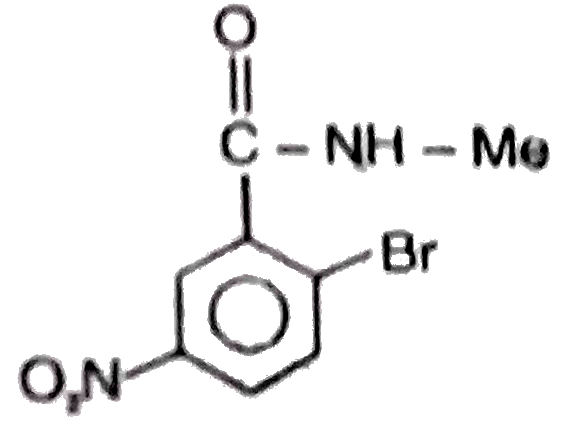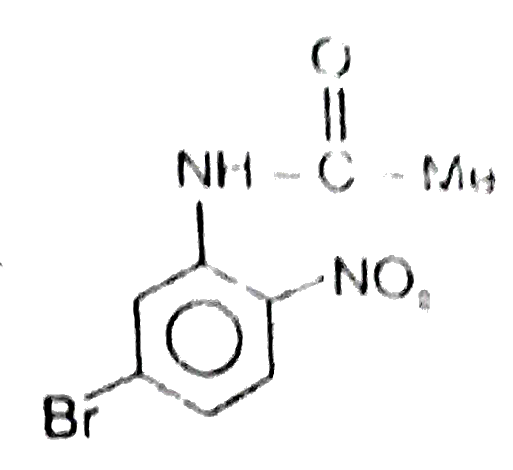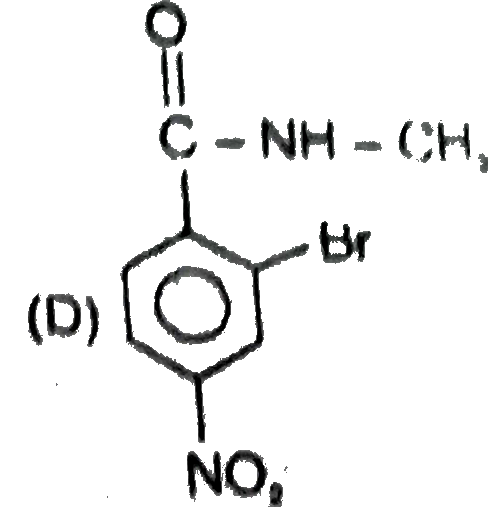Aldehydes and Ketones react with NH2OH to form aldoximes and Ketoximes respectively. Configuration of these compounds can be determined by Beckmann rearrangement as that group migrates which is anti w.r.t. -OH.

It is interesting to note that the migration of group is completely retentive and no loss of optical activity is seen.
Q. 




The correct Answer is:A
The migration of  which is anti to OH takes place.
which is anti to OH takes place.
Topper's Solved these Questions
- GENERAL ORGANIC CHEMISTRYBOOK - FIITJEECHAPTER - GENERAL ORGANIC CHEMISTRYEXERCISE - REASONING TYPE QUESTIONS
9 Videos
- GENERAL ORGANIC CHEMISTRYBOOK - FIITJEECHAPTER - GENERAL ORGANIC CHEMISTRYEXERCISE - MATCH THE FOLLOWING QUESTION
16 Videos
- GENERAL ORGANIC CHEMISTRYBOOK - FIITJEECHAPTER - GENERAL ORGANIC CHEMISTRYEXERCISE - MORE THAN ONE CORRECT CHOICES
24 Videos
- GASEOUS STATEBOOK - FIITJEECHAPTER - GASEOUS STATEEXERCISE - MATCHING LIST TYPE QUESTION
1 Videos
- HYDROCARBONSBOOK - FIITJEECHAPTER - HYDROCARBONSEXERCISE - SINGLE INTEGER ANSWER TYPE QUESTION
9 Videos
Similar Questions
Aldehydes and Ketones react with NH2OH to form aldoximes and Ketoximes respectively. Configuration of these can be determined by Beckmann rearragement as that group migrates which is anti w.r.t -OH

Which step is Rate determening step ?
View SolutionAlldehydes and Ketones react with NH2OH to form aldoximes and Ketoximes respectively. Configuration of these can be determined by Beckmann rearragement as that group migrates which is anti w.r.t -OH

[X]H2SO4−−−→H2O−−→Ph−NH2+CH3−C∣∣O−OH
Identify the configuration of [X] compound
View Solution
Knowledge Check
Aldehydes and Ketones reacts with NH2OH to form Aldoximes and Ketoximes respectively.Configuration of these can be determined by Beckmann rearrangement as that group migrates which is anti w.r.t-OH

It is interesting to note that the migration of group is completely retentive and no loss of optical activity is seen.
 Following is true about product AIt is also (+) laevorotatoryBBoth (+) and (-) forms are obtained in equal amountCIt is having 'S' configuration for chiral carbonDit is having R configuration for chiral carbon
Following is true about product AIt is also (+) laevorotatoryBBoth (+) and (-) forms are obtained in equal amountCIt is having 'S' configuration for chiral carbonDit is having R configuration for chiral carbonAldehydes and Ketones reacts with NH2OH to form Aldoximes and Ketoximes respectively.Configuration of these can be determined by Beckmann rearrangement as that group migrates which is anti w.r.t-OH

It is interesting to note that the migration of group is completely retentive and no loss of optical activity is seen.
 A
A B
B C
C D
D
Aldehydes and Ketones reacts with NH2OH to form Aldoximes and Ketoximes respectively.Configuration of these can be determined by Beckmann rearrangement as that group migrates which is anti w.r.t-OH

It is interesting to note that the migration of group is completely retentive and no loss of optical activity is seen.
CH3CHO+NH2OHΔ−−→PH⊕−−→QBr2/KOH−−−−−−→R(CH3NH2) (as only product) Following is correctAOxime P is syn form of geometrical isomersBOxime P is anti formCQ is more basic than RDQ is H−C∣∣O−NH−CH3
Alldehydes and Ketones react with NH2OH to form aldoximes and Ketoximes respectively. Configuration of these can be determined by Beckmann rearragement as that group migrates which is anti w.r.t -OH


The product (B) is :
View SolutionAlldehydes and Ketones react with NH2OH to form aldoximes and Ketoximes respectively. Configuration of these can be determined by Beckmann rearragement as that group migrates which is anti w.r.t -OH

Which step is Rate determening step ?
View SolutionAlldehydes and Ketones react with NH2OH to form aldoximes and Ketoximes respectively. Configuration of these can be determined by Beckmann rearragement as that group migrates which is anti w.r.t -OH

[X]H2SO4−−−→H2O−−→Ph−NH2+CH3−C∣∣O−OH
Identify the configuration of [X] compound
View SolutionMonosaccharides are polyhydric aldehydes and ketones which cannot be hydrolysed into simpler carbohydrates. The monosaccharides containing −CHO group are called aldoses while those containing C=O group are called ketoses. The aldehyde group is always present at C1 while keto group is generally present at C2. All monosaccharides are oxidised by Tollen's reagent and Fehling solution and are called reducing sugars.
The monosaccharide molecules may be assigned D and L-configurations depending upon whether the configuration of the molecule is related to D- or L-glyceraldehyde. If the −OH group is attached to the carbon adjacent to the −CH2OH group (last chiral carbon) is on the right hand side, it is assigned D-configuration. The molecule is assigned L-configuration if the -OH group attached to the carbon adjacent to the −CH2OH group is on the left. The monosaccharides contain one or more chiral carbon atoms. Pentoses and hexoses have cyclic structures furanose (five membered) and pyranose (six membered). During cyclization, C1 in aldohexoses and C2 in fructose become chiral and the newly formed -OH group may be either on the left or on the right in Fischer projection formulae. These monosaccharides, therefore, exist in two stereoisomeric forms called α-anomer and β-anomer while C1andC2 are called glycosidic or anomeric carbon. The bonds joining glycosidic carbon are called glycosidic linkages. D(+) glucose exists in two stereoisomeric forms, α-D- glucose and β-D-glucose. When either of these two forms of glucose i.e., α−D−glucose are dissolved in water and allowed to stand, these get slowly converted into other form and an equilibrium mixture of both is formed. This process is called mutarotation.
The maximum number of optical isomers of glucose expected are
View SolutionMonosaccharides are polyhydric aldehydes and ketones which cannot be hydrolysed into simpler carbohydrates. The monosaccharides containing −CHO group are called aldoses while those containing C=O group are called ketoses. The aldehyde group is always present at C1 while keto group is generally present at C2. All monosaccharides are oxidised by Tollen's reagent and Fehling solution and are called reducing sugars.
The monosaccharide molecules may be assigned D and L-configurations depending upon whether the configuration of the molecule is related to D- or L-glyceraldehyde. If the −OH group is attached to the carbon adjacent to the −CH2OH group (last chiral carbon) is on the right hand side, it is assigned D-configuration. The molecule is assigned L-configuration if the -OH group attached to the carbon adjacent to the −CH2OH group is on the left. The monosaccharides contain one or more chiral carbon atoms. Pentoses and hexoses have cyclic structures furanose (five membered) and pyranose (six membered). During cyclization, C1 in aldohexoses and C2 in fructose become chiral and the newly formed -OH group may be either on the left or on the right in Fischer projection formulae. These monosaccharides, therefore, exist in two stereoisomeric forms called α-anomer and β-anomer while C1andC2 are called glycosidic or anomeric carbon. The bonds joining glycosidic carbon are called glycosidic linkages. D(+) glucose exists in two stereoisomeric forms, α-D- glucose and β-D-glucose. When either of these two forms of glucose i.e., α−D−glucose are dissolved in water and allowed to stand, these get slowly converted into other form and an equilibrium mixture of both is formed. This process is called mutarotation.
Two forms of D-glucopyranose are called
View Solution
